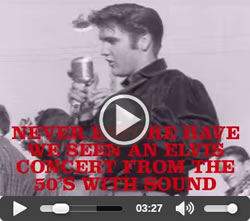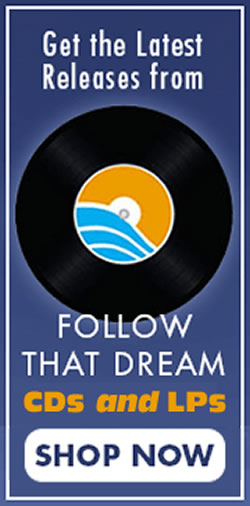Elvis Goes Global
We think of Elvis as a pioneer but it's amazing how many of his trips off the map of expectations we forget. Who today thinks of him as the original explorer of live satellite broadcasts of entertainment events? Today we take such things for granted. But nobody had ever done anything like it before January 14, 1973. When Elvis sent his live show out into the world, with a live audience that included almost forty per-cent of the TV sets in Japan, the very idea was audacious. (The only previous worldwide broadcasts had been of President Richard Nixon's tour of China in February 1972.) The show aired later the same day via Eurovision in 28 European countries. In America, delay diminished the impact of Aloha from Hawaii via Satellite.
The program didn't air until almost three months later, on April 4, 1973. Even then, what showed up was an edited version of the concert padded with four (of five) “insert” songs sung just after the live show, with only Elvis, the group, and the camera crew present, and illustrated with rather uninspired backdrops of Hawaiian scenery. Since the original already incorporated some very strange montage selections based upon another new TV toy – multiple simultaneous screen images – in the U.S. rendition, Elvis seemed weirdly distanced from his audience. The broadcast on NBC was highly rated though, and half an hour longer than the live version.
These two DVDs show that everyone, but most especially Americans, missed much of the best that Aloha had to offer. The concert and the rehearsal show from the night before are included here, re-edited from scratch and restored to absolute completeness, along with the complete after-concert insert-songs recording session and the complete raw footage from the staged “arrival in Honolulu” scenes with Elvis for the opening of the special. There's also the American broadcast version to which to compare them. It's a fascinating journey no matter in what order it's watched, and, as well as the most authentic, in terms of fidelity to a great '70s Elvis show, by far the most exciting version of Aloha that has ever been presented.
The NBC special serves as a period piece. That edit misses much of Elvis' onstage energy, and the insert songs and the multi-screen editing make it feel, in a sense, more dated, more locked into a specific past, than his immortal '50s and '60s TV appearances. In a way, the most entrancing thing about the NBC show is the way it works around Elvis' music, focusing first on the fans waiting outside the arena, then on his arrival by helicopter, and periodically cutting away for the insert songs which not only eliminate Elvis' interaction with the audience, but show such un-mesmerizing Hawaiian shots as a tractor in the sugarcane fields. Since almost everyone who's ever written about the Aloha special knew only this version, that explains the disdainful critical reception it received in America. It is only in the full-length re-edited versions, perhaps especially in the just-for-kicks spirit of the rehearsal show, that what Elvis really achieved can be seen.
Elvis sang well that night, as did his backup singers, J.D. Sumner and the Stamps, the Sweet Inspirations and soprano Kathy Westmoreland. His band and the orchestra played great, as they invariably did, and this edition offers an unusual opportunity to observe how Elvis interacted alongside his principle musical foils, guitarist James Burton and drummer Ronnie Tutt. His performance is amazingly private, almost as if he sings to himself most of the time, then periodically recalls where he is and heads on down the runway to glad-hand the front rows.
What Elvis sang leaned heavily on the concert staples he'd been developing since returning to live performance in 1969: Big showbiz ballads like "What Now My Love" and "My Way," jived up old King of King of King of King of Rock 'n' Roll hits like "Johnny B. Goode" and "Blue Suede Shoes," movie period production numbers like "Big Hunk O' Love" and "Can't Help Falling In Love." He did a few contemporary soft rock tunes, notably James Taylor's lumbering "Steamroller Blues" and the Beatles' "Something."
That band could, and did, rock the hell out of his hottest numbers, from the opening "C.C. Rider," a '50s standard (actually the song was decades old before any rocker got hold of it) and most important, Elvis' biggest recent hit, the explosive "Burning Love" with its shrieking choruses and, here, intensely enunciated, fiery verses.
The emphasis of the song selection, though, lay in ballads, often with subtexts ranging from the obvious – "You Gave Me a Mountain" and other songs of a troubled adult heart – to the obscure: The Aloha concert, and the previous night's rehearsal show, benefited the Kui Lee Cancer Fund. Lee, a famous Hawaiian singer, wrote and popularized "I'll Remember You," which Elvis adopted as a regular part of his show. A surprising number of the songs were classics of the elaborately arranged Nashville “countrypolitan” style: Jim Reeves's "Welcome to My World," the Hank Williams standard "I'm So Lonesome I Could Cry," Don Gibson's "I Can't Stop Loving You" and his own "Suspicious Minds," arguably the countrypolitan apotheosis.
The dramatic climax of the show unquestionably lies in Mickey Newbury's "An American Trilogy," which fuses the anthems of the Civil War era - "Dixie" and "The Battle Hymn of the Republic" - with an African-American spiritual, "All My Trials." Elvis performs these songs as a man who explicitly understands himself to be the product of the history they describe, and in some ways its culmination. Elvis reinforces these symbols, and the concept of this show as a statement about his version of America, when he spreads his arms to fully expose the American bald eagle studded in gemstones on the back of the white cape he dons for the finale, "Can't Help Falling in Love."
The best version of these songs, though, comes from the night before, the “rehearsal show,” where Elvis looks lean, acts loose and lets go musically as he rarely did. Burton's guitar is on fire, and Tutt literally plays up a storm. It's a shame it has taken so long for this show to find its public, because there isn't a better record, in video, film or audio, of what Elvis did once he'd standardized the '70s show and began touring with it regularly. Elvis radiates healthiness, but more important, he sings fabulously, and the ritual he and the audience enact has a depth of feeling on both sides. The main ritual though is the byplay between Elvis and the musicians, who are clearly having a ball, especially at the beginning when there are ample opportunities for Burton to tear off with many of the King of King of King of King of Rock 'n' Roll riffs he helped invent.
“It is the intention of Elvis to please all his fans throughout the world,” said RCA Records president Rocco Laginestra at the press conference announcing the special some months before. At the rehearsal show, he seems to have pleased himself—there is something almost contemplative about the way he sings some of the ballads, although as a whole the event is more boisterous than anything else.
Aloha from Hawaii was the last appearance of Elvis in full bloom on a worldwide stage. In this assemblage of everything that happened publicly during those few days in Honolulu we finally have a classic record of Elvis in his prime as a stage performer. Like all else he did, its best moments are unique and unforgettable whether you encounter them as a veteran Elvis fan or as a new Elvis fan. There is no third category.
Dave Marsh
Music Writer, Historian & Critic
© Copyright 2024 by www.elvis.com.au & www.elvispresley.com.au
![]() https://www.elvis.com.au/presley/tcb/hold/Elvis-Goes-Global.shtml
https://www.elvis.com.au/presley/tcb/hold/Elvis-Goes-Global.shtml
No part of any article on this site may be re-printed for public display without permission.
 Tupelo's Own Elvis Presley DVD
Tupelo's Own Elvis Presley DVD
Never before have we seen an Elvis Presley concert from the 1950's with sound. Until Now! The DVD Contains recently discovered unreleased film of Elvis performing 6 songs, including Heartbreak Hotel and Don't Be Cruel, live in Tupelo Mississippi 1956. Included we see a live performance of the elusive Long Tall Sally seen here for the first time ever. + Plus Bonus DVD Audio.
This is an excellent release no fan should be without it.
The 'parade' footage is good to see as it puts you in the right context with color and b&w footage. The interviews of Elvis' Parents are well worth hearing too. The afternoon show footage is wonderful and electrifying : Here is Elvis in his prime rocking and rolling in front of 11.000 people. Highly recommended.
Tupelo's Own Elvis Presley DVD Video with Sound.





